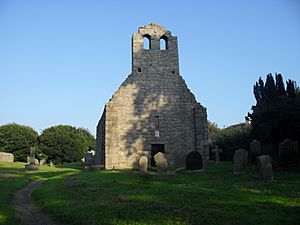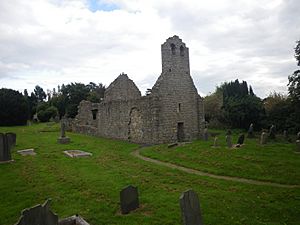Kill of the Grange facts for kids
Quick facts for kids Kill of the Grange |
|
|---|---|
| Kill o' the Grange, Clonken | |
|
Cill na Gráinsí, Cluinchenn
|
|
 |
|
| 53°16′53″N 6°09′40″W / 53.281377°N 6.160982°W | |
| Location | Kill of the Grange, Deansgrange, Blackrock, County Dublin |
| Country | Ireland |
| Denomination | Pre-Reformation Catholic |
| History | |
| Founded | 11th century |
| Architecture | |
| Style | Norman |
| Years built | 11th century |
| Closed | 16th century |
| Specifications | |
| Length | 17 m (56 ft) |
| Width | 7 m (23 ft) |
| Materials | Stone |
| Administration | |
| Diocese | Dublin |
Kill of the Grange is an ancient religious site in County Dublin, Ireland and a National Monument.
Contents
Location
Kill of the Grange lies 1.7 km (1.1 mi) inland, on the south side of Dublin Bay. In modern times it is surrounded by housing developments and is found in Deansgrange, Blackrock, County Dublin.
Structures
The church is associated with St Finnian of Clonard and dates from the 11th century. Parts may date to the 6th century as they are similar to remains found at Glendalough. The church was originally a simple oblong (now the nave) and a chancel and belfry were later added.
Originally known as Clonkeen (Irish: Cluinchenn), it is now known as Kill of the Grange, meaning "church of the monastic grange."
There is also a bullaun (about 25 cm (9.8 in) across) and holy well on the site.
Churches
There are two churches still in use. The Church of Ireland Church close to the traffic Lights. designed in 1863 by William John Welland and John Gillespie who were architects to the Ecclesiastical Commissioners. the church was consecrated in 1864. It is on a rectangular plan with a double height apse.
The Roman Catholic Church near Bakers Corner. The Catholic church from the 1970's is often described as 'The boiler house' and is an exercise in the control of light from above.
Houses
The area is thick with historic houses of which one, Known as Kill Abbey, was originally built in 1595 by John Usher. The house is now much modified but still represents the oldest house in Dun Laoghaire Rathdown area.
History
The site was part of the possessions of the Priory of the Holy Trinity (later Christ Church Cathedral, Dublin) and their records give a vivid picture of the 14th-century monastic site at Clonken / Kill o' the Grange, describing the construction of a kiln house with thatched roof and wattle and daub walls, and the grange itself being built from timber bought from the native Irish (probably in the Dublin Mountains).



